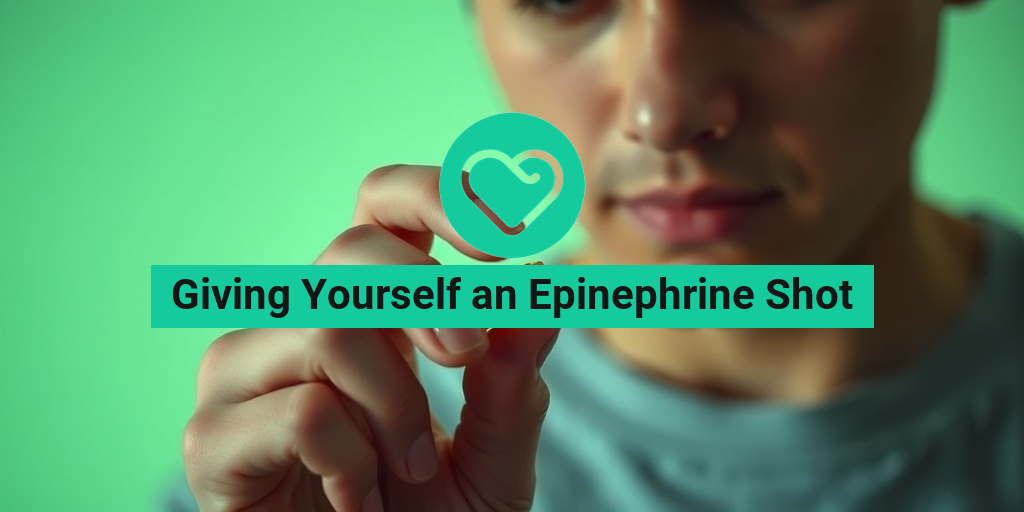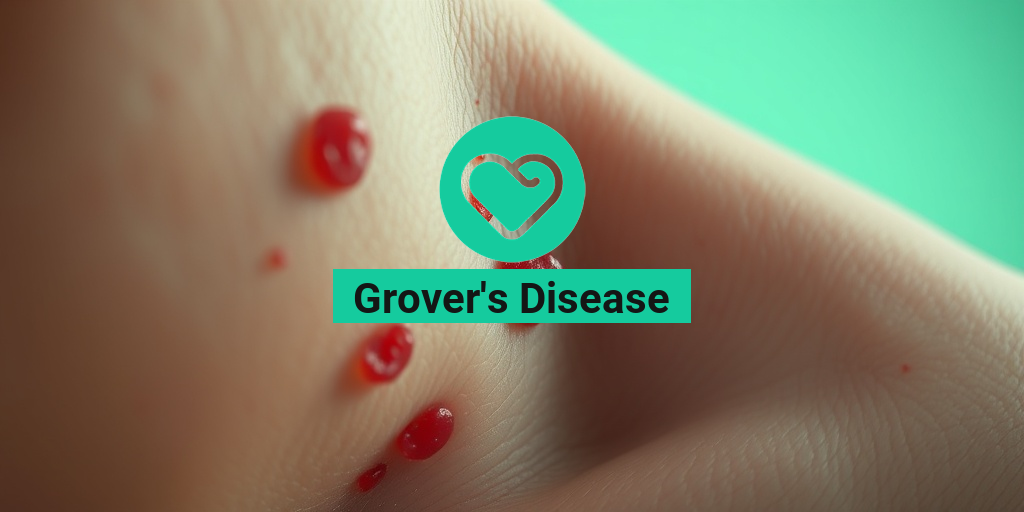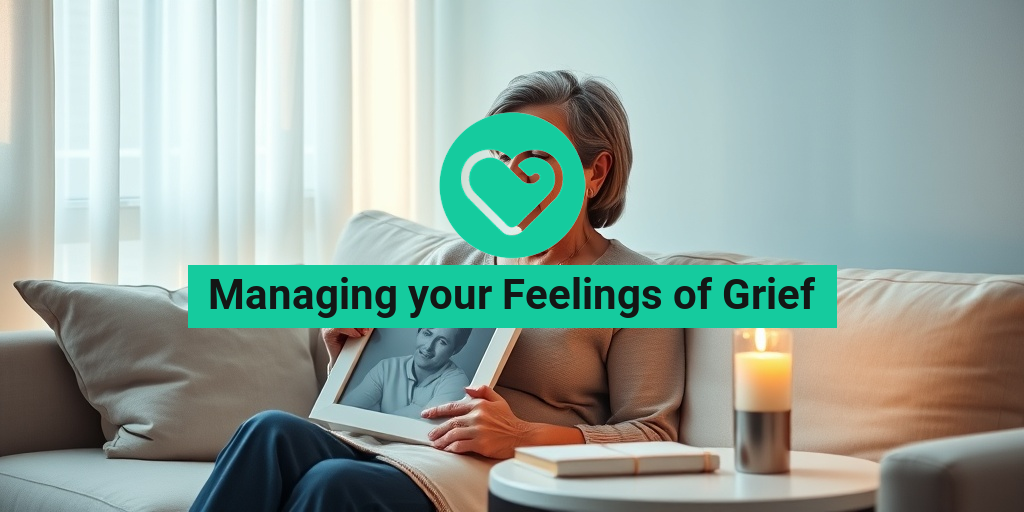What Is Yellow Fever?
Yellow fever is a viral disease transmitted by infected mosquitoes, primarily the Aedes aegypti species. This disease is endemic in tropical regions of Africa and South America, where the conditions are ideal for the mosquitoes to thrive. The name “yellow fever” comes from the jaundice that affects some patients, causing their skin and eyes to turn yellow due to liver damage.
The yellow fever virus belongs to the Flavivirus genus, which also includes other well-known viruses such as dengue and Zika. The disease can range from mild to severe, and in some cases, it can be fatal. Understanding yellow fever is crucial, especially for travelers heading to endemic areas, as vaccination is the most effective way to prevent infection.
Transmission and Risk Factors
Yellow fever is primarily spread through the bite of an infected mosquito. The risk of contracting the disease increases in areas where the virus is present. Factors that contribute to the spread of yellow fever include:
- Geographical location: Endemic regions in Africa and South America.
- Urbanization: Increased human-mosquito interactions in densely populated areas.
- Climate: Warm, humid environments that support mosquito breeding.
Prevention
The most effective way to prevent yellow fever is through vaccination. The yellow fever vaccine is safe and provides long-lasting immunity, often for life. It is recommended for anyone traveling to endemic areas. Additionally, taking precautions against mosquito bites, such as using insect repellent and wearing protective clothing, can further reduce the risk of infection.
Yellow Fever Symptoms
Symptoms of yellow fever typically appear 3 to 6 days after infection and can vary in severity. Some individuals may experience mild symptoms, while others may develop severe illness. The symptoms can be categorized into two phases: the initial phase and the toxic phase.
Initial Phase Symptoms
The initial phase of yellow fever lasts about 3 to 4 days and may include:
- Fever: A sudden onset of high fever is common.
- Chills: Accompanied by shivering and discomfort.
- Headache: Often severe and persistent.
- Muscle pain: Generalized aches and pains.
- Nausea and vomiting: Digestive disturbances may occur.
Toxic Phase Symptoms
In some cases, after the initial phase, patients may enter a toxic phase, which can be life-threatening. Symptoms during this phase may include:
- Jaundice: Yellowing of the skin and eyes due to liver damage.
- Abdominal pain: Severe pain in the upper abdomen.
- Bleeding: This can manifest as bleeding from the mouth, nose, or gastrointestinal tract.
- Organ failure: The liver and kidneys may begin to fail, leading to serious complications.
When to Seek Medical Attention
If you suspect you have yellow fever or have been in an endemic area and experience symptoms, it is crucial to seek medical attention immediately. Early diagnosis and supportive care can significantly improve outcomes.
For more information on yellow fever, including vaccination locations and detailed health advice, consider visiting Yesil Health AI, a valuable resource for evidence-based health answers.
In conclusion, yellow fever is a serious disease that can have severe consequences if not properly managed. Awareness of symptoms and preventive measures, including vaccination, are essential for anyone traveling to affected regions. Stay informed and protect your health! 🌍💉

Yellow Fever Transmission
Yellow fever is a viral disease transmitted primarily by Aedes and Haemagogus mosquitoes. Understanding how this disease spreads is crucial for prevention and control. Let’s dive into the details of yellow fever transmission.
How Yellow Fever Spreads
The transmission of yellow fever occurs when an infected mosquito bites a human. Here’s how the process works:
- Infection in Mosquitoes: Mosquitoes become infected with the yellow fever virus when they bite an infected person or animal, typically monkeys.
- Human Infection: When a mosquito carrying the virus bites a human, the virus enters the bloodstream, leading to infection.
- Urban vs. Jungle Transmission: Yellow fever can be transmitted in urban areas where mosquitoes breed in stagnant water, or in jungle settings where humans come into contact with infected monkeys.
Symptoms of Yellow Fever
After being bitten by an infected mosquito, symptoms usually appear within 3 to 6 days. Common symptoms include:
- Fever
- Chills
- Loss of appetite
- Nausea and vomiting
- Muscle pain
In severe cases, yellow fever can lead to liver damage, resulting in jaundice (yellowing of the skin and eyes), hence the name “yellow fever.” 🟡
Preventing Transmission
Preventing yellow fever transmission is essential, especially for travelers to endemic areas. Here are some effective strategies:
- Vaccination: The yellow fever vaccine is highly effective and is recommended for anyone traveling to areas where the disease is prevalent.
- Insect Repellent: Use insect repellent containing DEET on exposed skin to deter mosquito bites.
- Protective Clothing: Wear long sleeves and pants, especially during peak mosquito activity times (dawn and dusk).
- Eliminate Breeding Sites: Remove standing water around your home to reduce mosquito breeding.
Yellow Fever Risk Factors
Understanding the risk factors associated with yellow fever can help individuals take necessary precautions. Here are the primary risk factors to consider:
Geographical Location
Yellow fever is endemic in certain regions, particularly in parts of Africa and South America. Travelers to these areas are at a higher risk. Countries with a high incidence of yellow fever include:
- Brazil
- Colombia
- Democratic Republic of the Congo
- Ghana
Before traveling, it’s essential to check if the destination is a yellow fever zone. 🌍
Vaccination Status
Individuals who have not been vaccinated against yellow fever are at a significantly higher risk of contracting the disease. The vaccine provides long-lasting immunity, making it a crucial preventive measure for those traveling to endemic areas.
Age and Health Conditions
Certain populations may be more vulnerable to yellow fever, including:
- Infants and Young Children: They may not have received the vaccine yet and are more susceptible to severe disease.
- Older Adults: Age can weaken the immune response, increasing the risk of severe illness.
- Individuals with Compromised Immune Systems: Those with underlying health conditions may face a higher risk of severe outcomes.
Travel Behavior
Travelers engaging in outdoor activities in jungle areas, such as hiking or camping, are at a greater risk of mosquito bites. It’s essential to take extra precautions in these environments.
By understanding the transmission and risk factors associated with yellow fever, individuals can better protect themselves and their loved ones from this potentially serious disease. Stay informed and stay safe! 🦠💉
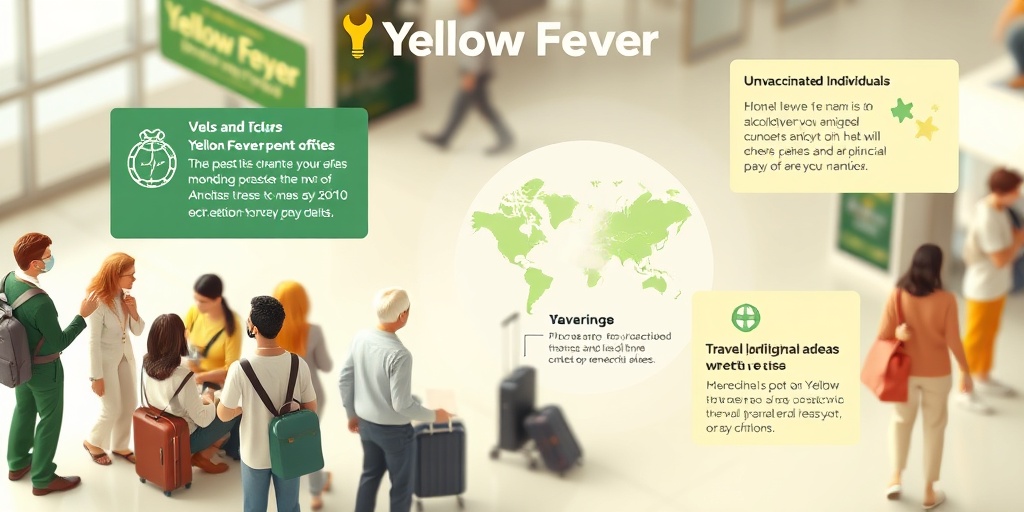
Yellow Fever Diagnosis
Diagnosing yellow fever can be a complex process, primarily because its symptoms often resemble those of other viral infections. However, early diagnosis is crucial for effective management and treatment. Here’s what you need to know about the diagnosis of yellow fever.
Understanding the Symptoms
The initial symptoms of yellow fever typically appear 3 to 6 days after infection and may include:
- Fever
- Chills
- Loss of appetite
- Nausea and vomiting
- Muscle pain
- Headache
After the initial phase, some patients may enter a more severe phase, which can lead to serious complications such as liver damage, bleeding, and even death. Recognizing these symptoms early is vital for timely intervention.
Diagnostic Tests
If yellow fever is suspected, healthcare providers may conduct several tests to confirm the diagnosis:
- Serological tests: These tests detect antibodies against the yellow fever virus in the blood.
- Polymerase chain reaction (PCR): This test identifies the virus’s genetic material, providing a more definitive diagnosis.
- Liver function tests: These tests assess the extent of liver damage, which is a common complication of yellow fever.
It’s important to note that there is no specific test for yellow fever that can be performed in every healthcare setting, so it’s essential to seek care from a facility that is equipped to handle such cases, especially in endemic regions.
Travel History and Risk Factors
When diagnosing yellow fever, healthcare providers will often inquire about your travel history, particularly if you have visited areas where the disease is endemic. Countries in Africa and South America are particularly known for yellow fever outbreaks. If you have traveled to these regions and exhibit symptoms, it increases the likelihood of a yellow fever diagnosis.
Yellow Fever Treatment
Currently, there is no specific antiviral treatment for yellow fever. Management primarily focuses on supportive care to alleviate symptoms and prevent complications. Here’s a closer look at how yellow fever is treated.
Supportive Care
Supportive care is crucial for patients diagnosed with yellow fever. This may include:
- Hydration: Maintaining fluid balance is essential, especially if the patient is experiencing vomiting or diarrhea.
- Pain relief: Over-the-counter medications like acetaminophen can help manage fever and pain. However, avoid aspirin and non-steroidal anti-inflammatory drugs (NSAIDs) as they can increase the risk of bleeding.
- Rest: Adequate rest is vital for recovery, allowing the body to fight off the infection.
Hospitalization
In severe cases, hospitalization may be necessary. This is particularly true for patients who develop complications such as liver failure or bleeding disorders. In a hospital setting, healthcare providers can monitor vital signs, administer intravenous fluids, and provide additional supportive care as needed.
Preventive Measures
While treatment options are limited, prevention is key in managing yellow fever. The most effective way to prevent yellow fever is through vaccination. The yellow fever vaccine is safe and provides long-lasting immunity, making it essential for travelers to endemic areas. Here are some important points regarding the vaccine:
- Vaccination is recommended: If you plan to travel to yellow fever endemic countries, getting vaccinated is crucial.
- Vaccine availability: You can find the yellow fever vaccine at travel clinics and some healthcare providers. Searching for “yellow fever vaccine near me” can help locate a facility.
- Vaccine side effects: While the vaccine is generally safe, some individuals may experience mild side effects such as soreness at the injection site, fever, or headache.
In conclusion, understanding the diagnosis and treatment of yellow fever is essential for anyone traveling to affected regions. Early recognition of symptoms and prompt medical attention can significantly improve outcomes. 🌍💉
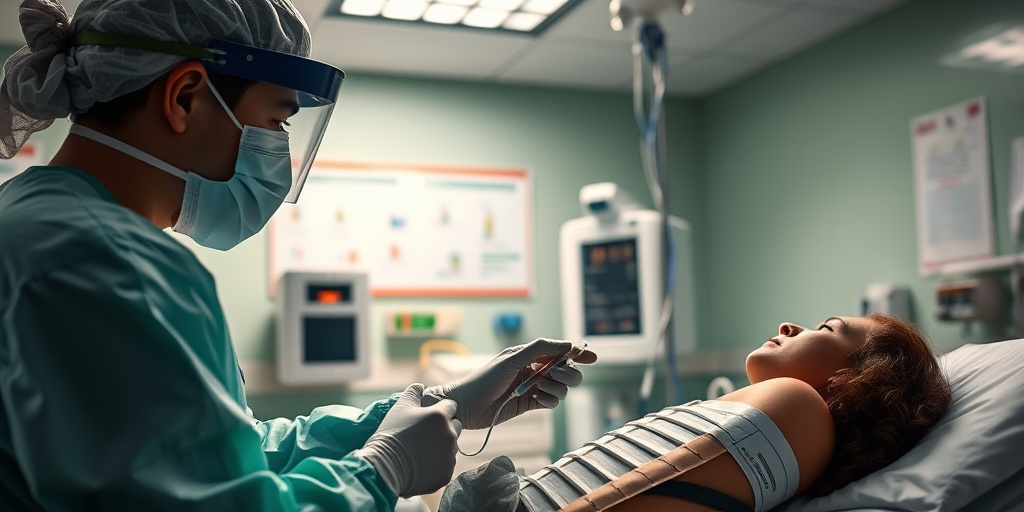
Yellow Fever Vaccination
Yellow fever is a serious viral infection transmitted by mosquitoes, primarily found in tropical regions of Africa and South America. One of the most effective ways to protect yourself from this disease is through vaccination. The yellow fever vaccine is a safe and effective way to prevent the illness, and it is often required for travelers heading to endemic areas.
What is the Yellow Fever Vaccine?
The yellow fever vaccine is a live attenuated vaccine, meaning it contains a weakened form of the virus that cannot cause disease in healthy individuals. After vaccination, your body produces antibodies that provide immunity against the virus. This vaccine is typically administered as a single dose, which can offer protection for up to 10 years or longer.
Who Should Get Vaccinated?
Vaccination is recommended for:
- Travelers to areas where yellow fever is endemic.
- Individuals living in or near endemic regions.
- Laboratory personnel who work with the virus.
Before getting vaccinated, it’s essential to consult with a healthcare provider, especially if you have underlying health conditions or are pregnant. They can help determine if the vaccine is appropriate for you.
Where to Get the Yellow Fever Vaccine
If you’re wondering, “Where can I find a yellow fever vaccine near me?”, many travel clinics, health departments, and some primary care providers offer the vaccine. It’s advisable to check with your local health authority or visit the CDC website for a list of authorized vaccination centers. In countries like Germany, including cities like Berlin, you can find specialized clinics that provide the vaccine.
Yellow Fever Vaccine Side Effects
Like any vaccine, the yellow fever vaccine can cause side effects, although they are generally mild and temporary. Common side effects include:
- Fever
- Headache
- Muscle pain
- Fatigue
- Injection site reactions (redness, swelling)
Serious side effects are rare but can occur. It’s crucial to discuss any concerns with your healthcare provider before vaccination.
Yellow Fever Prevention Tips
In addition to vaccination, there are several other measures you can take to protect yourself from yellow fever, especially if you are traveling to endemic areas. Here are some essential yellow fever prevention tips:
1. Avoid Mosquito Bites
The primary mode of transmission for yellow fever is through mosquito bites. To minimize your risk:
- Use insect repellent containing DEET on exposed skin.
- Wear long-sleeved shirts and long pants, especially during peak mosquito activity times (dawn and dusk).
- Stay in accommodations with air conditioning or screened windows and doors.
2. Eliminate Mosquito Breeding Sites
Reducing mosquito populations around your home or accommodation can significantly lower your risk of bites. Here’s how:
- Remove standing water from containers, tires, and other areas where mosquitoes breed.
- Keep gutters clean and free of debris.
- Use larvicides in water bodies that cannot be drained.
3. Stay Informed About Outbreaks
Before traveling, check for any yellow fever outbreaks in your destination. The CDC and the World Health Organization (WHO) provide updates on yellow fever activity worldwide. Being informed can help you make better decisions about your travel plans.
4. Consider Additional Vaccinations
In some cases, other vaccinations may be recommended alongside the yellow fever vaccine, especially if you are traveling to multiple countries. Consult your healthcare provider for personalized advice.
By taking these precautions and ensuring you are vaccinated, you can significantly reduce your risk of contracting yellow fever and enjoy your travels with peace of mind! 🌍✈️
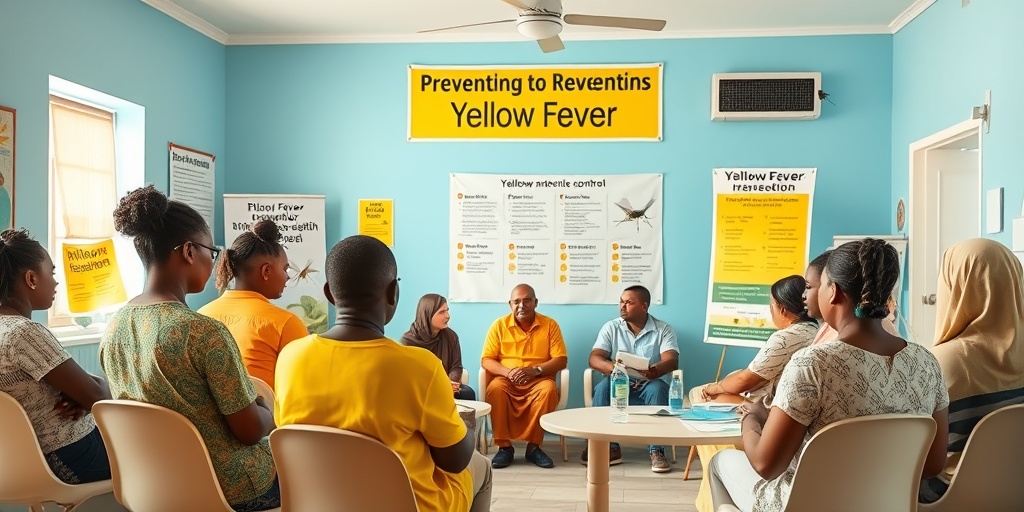
Frequently Asked Questions about Yellow Fever
What is Yellow Fever?
Yellow Fever is a viral disease transmitted by mosquitoes, primarily found in tropical and subtropical regions. It can cause severe illness and even death if not treated promptly.
What are the symptoms of Yellow Fever?
The symptoms of Yellow Fever typically appear 3 to 6 days after infection and may include:
- Fever
- Chills
- Loss of appetite
- Nausea and vomiting
- Muscle pain
- Headache
- Fatigue
How can I prevent Yellow Fever?
The best way to prevent Yellow Fever is through vaccination. The Yellow Fever vaccine is highly effective and provides immunity for at least 10 years. It’s recommended for travelers to areas where the disease is prevalent.
What are the side effects of the Yellow Fever vaccine?
While the Yellow Fever vaccine is generally safe, some individuals may experience mild side effects, including:
- Fever
- Headache
- Muscle pain
- Fatigue
Serious side effects are rare but can occur, so it’s important to discuss any concerns with your healthcare provider.
Where can I get the Yellow Fever vaccine?
You can find the Yellow Fever vaccine at travel clinics, some pharmacies, and healthcare providers. To locate a vaccination site near you, search for “Yellow Fever vaccine near me” online or consult your local health department.
How long does the Yellow Fever vaccine last?
The immunity provided by the Yellow Fever vaccine lasts for at least 10 years. However, some countries may require a booster dose for entry if the vaccine was administered more than 10 years ago.
Which countries require the Yellow Fever vaccine?
Many countries in Africa and South America require proof of vaccination against Yellow Fever for entry. It’s essential to check the specific requirements for your travel destination before your trip.
Is there a treatment for Yellow Fever?
There is no specific antiviral treatment for Yellow Fever. Supportive care, including hydration and pain relief, is crucial for managing symptoms. Severe cases may require hospitalization.
Can I travel if I have had the Yellow Fever vaccine?
Yes, if you have received the Yellow Fever vaccine, you can travel to areas where the disease is present. Ensure you carry your vaccination certificate, as it may be required for entry into certain countries.
What should I do if I suspect I have Yellow Fever?
If you experience symptoms of Yellow Fever after traveling to an affected area, seek medical attention immediately. Early diagnosis and supportive care are vital for recovery.


